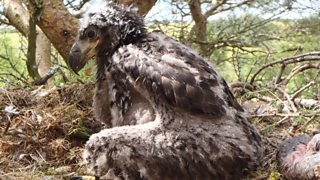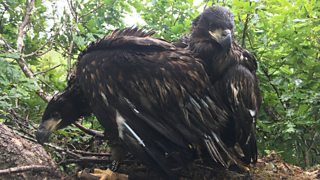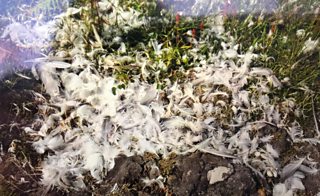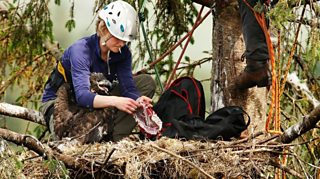By Dave Sexton, RSPB Scotland Mull Officer
It’s fair to say that after 30 odd years of assisting with post breeding nest clear-outs of white-tailed eagles, we’ve seen a vast array of prey items represented. In fact, it’s pretty clear that as both scavengers and hunters there’s not much they’ll turn their noses (beaks!) up at. The studies over many decades have given us a fascinating insight into what they will eat and what their particular favourites are. The limitations of such studies though are that they’ll tell us what they’ve carried into a nest but generally not how it was obtained in the first place. Was something dead and scavenged from something like an otter or was it alive when it was caught? Sea eagles are very keen on one way of obtaining a free meal: kleptoparasitism. As we saw in Autumnwatch 2021 on Mull, cameraman Jim Manthorpe got some incredible footage of an adult sea eagle trying to steal a fish supper from an otter. We see them doing this a lot. They’ll also chase down gannets, herons and gulls if they think there’s a freshly caught fish in their gullets. In the pursuit, the desperate gannet will throw up the mackerel it’s just caught in an attempt to avoid becoming dinner itself. And it’s very effective. The sea eagle diverts to pick up the fish and the gannet flies on to fish another day.

A sea eagle chick at about 5-6 weeks old. Food will be coming in regularly at this point with both adults provisioning the rapidly growing chick. Credit: Justin Grant
Some people call sea eagles ‘lazy’. It’s not a word I would use to describe their habits. More like ‘efficient’. They will sit for many hours, just waiting and watching. If they see activity in the distance, like crows, gulls and ravens feeding on something, they’ll eventually go and investigate and claim whatever prey item is there, dead or alive.

Just 5-6 weeks later and the chicks are fully grown and ready to take their first flight. After a few weeks, once they鈥檙e fledged and clear of the nest area, it鈥檚 possible to inspect the nest for prey remains without disturbing the birds. All checks are carried out under licence. Credit: Rhian Evans
But it’s this behaviour which can sometimes get them into trouble and it’s what’s given them something of a bad reputation over the Centuries. Whilst we know some pairs of both golden eagles and sea eagles can take live lambs each year, sea eagles, in particular, are far more likely to be tempted into a carcass by first watching other predators at work. It’s something I’ve witnessed many times but inevitably it’s the eagle that gets the blame. They’re big, bold and get noticed. Where livestock is being affected, there is help and advice and a to offer practical advice, pragmatic solutions and financial help. It can’t solve every problem but it is a recognition that living alongside predators like eagles, though exciting for some of us, is also genuinely challenging and problematic for others. And we need to respect that and help where we can.

Prey remains found near to nests are also checked. A careful sniff of this pile of feathers and the pungent oily aroma which stays in your nostrils for hours afterwards confirms this was a fulmar caught by the sea eagles out over the sea and carried back to shore to pluck before being carried into the nest to feed the chicks. Credit: Dave Sexton
So, any lamb, other mammal, bird or occasional fish bones that are found in sea eagle nests only tell us what they’ve carried in to feed growing chicks and it’s a fascinating story. The textbooks tell us they feed mainly on fish (their bones are rarely found as they get digested or rot away), birds and mammals but different pairs vary on what makes up the bulk of their breeding season diet. Some are expert fulmar hunters; others go more for rabbits and hares whilst others make a living from taking fish off others, including us! They follow fishing and tourist boats for free handouts and have probably been scavenging off mankind since Neolithic times.

Licenced, experienced climbers ring and measure chicks, check for prey remains and then return after fledging to finish the detective work. Credit: Nic Davies
Studying prey remains is wonderful ‘CSI’ forensic detective work but it doesn’t tell the whole story. I once watched a live octopus desperately trying to crawl out of a sea eagle nest 30 feet up a tree! Long tentacles kept appearing over the nest rim only to be dragged back in by the adult eagle waiting to feed its chick. It had probably been stolen off an otter. Eventually, it was completely eaten and not surprisingly, no octopus remains were found in that nest clear out! Nest investigations off us a glimpse into their world but some things just vanish without a trace…
